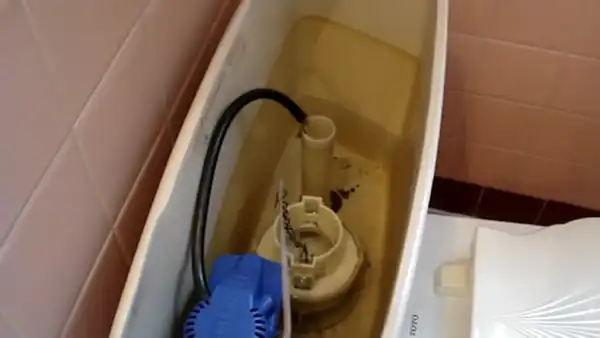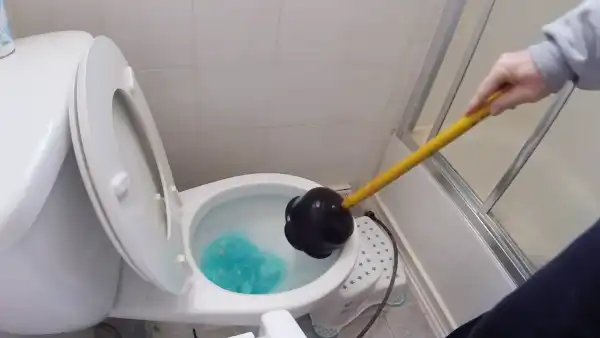Last Updated on October 18, 2023
When none of your toilets flush, the morning rush or a busy household can quickly become a headache. Your toilets may not flush for several reasons.
It could be as simple as a disconnected toilet handle, where pressing it achieves nothing. Low water levels in the tank might also impede flushing, resulting in ineffective waste removal. Another culprit might be a malfunctioning flapper, causing your toilet to run continuously after a flush.
We’ll explore the common causes and provide insights into how to address this issue, ensuring a return to normalcy in your daily routine.
None of My Toilets Are Flushing: Reasons and Solutions

If your toilet handle is not flushing properly, there could be several reasons for this issue.
- Problem with the toilet handle
- Low tank water level
- Flapper or fill valve problem
- Drain line problem
Let’s look at each cause of toilet flushing and possible solutions so you can quickly resolve the issue.
Problem with the Toilet Handle
When your toilet handle moves freely, but nothing happens when you press it, there’s likely an issue with the flushing mechanism.
This often involves the handle, arm, and chain inside the tank. The handle might be disconnected from the chain, preventing it from effectively triggering the flushing process.
To fix this issue, you need to inspect the inside of the toilet tank. Remove the lid and carefully examine the handle, arm, and chain. Look for any signs of disconnection or damage. If you see that the handle or chain is broken or disconnected, it’s time for a replacement.
To replace the handle and chain, first turn off the water supply to your toilet. Disconnect the old handle from the flush valve assembly and remove any remaining pieces of the old chain.
Next, attach the new handle securely to the flush valve assembly using a nut or screw provided with your replacement kit. Then, securely connect a new chain to both ends and adjust its length if needed.
Low Tank Water Level
Insufficient water in the toilet tank can hinder the flushing process. When the water level is too low, there might not be enough force to flush down waste and paper effectively.
To resolve the issue of low tank water levels, you should open the toilet tank and check the water level. You need to adjust the float mechanism if it’s below the recommended level.
The float is responsible for controlling the water level in the tank. You can bend the float arm downward to allow more water to fill the tank. Alternatively, you can adjust the float valve if your toilet has a modern fill valve.
This will ensure enough water in the tank for a proper flush. Insufficient water in the tank can cause problems with flushing waste and paper effectively.
Flapper or Fill Valve Problem
If your toilet starts to flush but doesn’t stop running afterward, you might have a problem with the flapper. The flapper is the rubber piece at the bottom of the tank that creates a seal, while the fill valve controls the water intake.
When there’s an issue with the flapper or fill valve, check for signs of damage or misalignment. Examine the flapper closely for any cracks, warping, or improper sealing. If you notice any of these issues, replacing the flapper is necessary to resolve your toilet flushing problem.
Also, hard water buildup can affect the performance of the fill valve. Try cleaning it first, but if problems persist, consider replacing either the flapper or fill valve.
You can find these parts at most hardware stores and follow step-by-step instructions to ensure proper replacement.
Drain Line Problem
When your toilet won’t flush despite all internal components working, the issue might be related to the drain line. This can include clogs, breaks, or root intrusion in the drain lines.
If you suspect a drain line problem, grab a toilet auger or plumbing snake, a sturdy bucket, rubber gloves for hygiene, and a flashlight to illuminate the area.
Insert the auger into the toilet’s drain opening and gently guide it into the drain line while turning the handle. Continue until you sense that the auger is moving without significant resistance, indicating that the clog might have been successfully addressed.
Following your attempt to clear the clog, test the toilet’s flush. If you observe a smoother flow of water and improved flushing, it’s likely that the clog has been resolved.
How can you ensure the toilet’s inlet holes are clear for proper flushing?
To ensure that your toilet’s inlet holes remain clear and function properly, it is essential to perform periodic cleaning routines using hot water and vinegar.
This natural cleaning solution helps dissolve mineral deposits and debris that can accumulate over time, leading to potential blockages. Start by preparing the mixture and then gently pour it into the toilet’s tank, allowing it to flow through the inlet holes.
To ensure optimal cleaning results, you can also use a brush or toothpick to dislodge any visible debris that may cling to the openings. This proactive approach helps maintain a steady water flow during flushing.
How often should you inspect and maintain your toilets to prevent flushing issues?

To prevent flushing issues and ensure your toilets function smoothly, it’s advisable to inspect and maintain them at least once within six months.
During these routine checks, remove the tank lid and perform a flushing operation to observe its inner workings.
Confirm that the flapper, which is attached to the toilet handle via a small chain, seals fully after flushing, and ensure that the fill valve is turned off at the correct water level.
Besides maintaining your flushing mechanism, you must also focus on preventing general toilet clogging.
To avoid blockages, practice responsible flushing habits by disposing of items like sanitary products, paper towels, and excessive toilet paper in the trash rather than flushing them.
If clogging occurs in your toilets, address it promptly using a plunger. Clean the toilet plunger after use to maintain proper hygiene and prevent contamination.
Identify and Resolve Toilet Issues for a Hygienic Environment
When dealing with toilets that don’t flush properly, remember the common causes outlined above. There’s a range of possibilities, from issues with the toilet handle to low tank water levels, malfunctioning flappers, and even drain line problems.
Diagnosing the specific problem and applying the appropriate fix can swiftly restore your toilets’ functionality and bring your daily routine back to normal.
You can improve your toilet’s performance by adjusting the handle, tweaking the float valve, replacing the flapper, or clearing the drain line.

